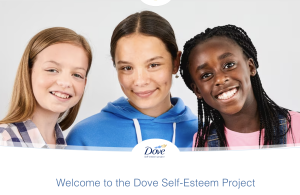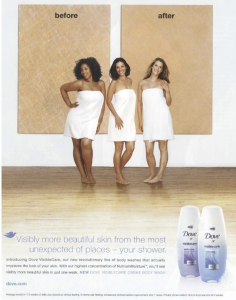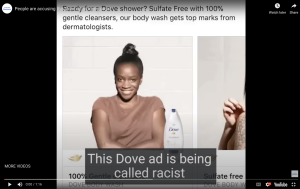Food for Thought
- Advertising mirrors and influences society and culture
- Society and culture influences Advertising
- Brands who are not culturally literate risk damaging their reputation and consumer trust
- Professors, students and advertising practitioners have a responsibility to be culturally literate
Reflect Your Consumers
As an advertising professional, it’s your responsibility to make sure your campaign ideas are on trend. It’s also your responsibility to make sure those ideas are not culturally insensitive, tone deaf, or offensive.
What does that mean? Let’s not mince words. The majority of the advertising we see is not as diverse, equitable, and inclusive as it could be. But you have the ability to help change that by making sure your work represents in pictures and words the people you are marketing to. You can be the change you want to see.
WARNING: Some of the material below is insensitive and or offensive. I share it not to trigger but as a cautionary tale.
Cultural Literacy Brand Examples
- Dove
- Pepsi
- Renault
- Stil Vodka
Today, Dove is lauded for being a champion of real beauty and body positivity. It’s know for creating ad campaigns that challenge unrealistic societal norms of beauty. The brand has tackled issues that matter to women, from self esteem to workplace hair bias. But Dove’s advertising hasn’t always been so enlightened.


Here are just a few examples of how Dove fell short, starting with a 2011 Dove ad that seemed to imply that for a black woman to be attractive, she’d need to lighten her skin using Dove body wash.
Here’s the Facebook ad.

Understandably, the ad caused a furor.
But did Dove learn its lesson? Apparently not. In 2017, the company posted a 3-second video on its Facebook page showing a black woman removing her top to reveal a white woman underneath. Taken together, these (and other Dove ads) seemed to provide evidence of Dove’s history of racially-insensitive marketing.
This Business Insider article includes the video and discusses why consumers threatened to boycott Dove.

As a result, the brand’s reputation was seriously damaged and many consumers lost trust in the brand their family had been using for generations.
How did this happen? How could ads like this get approved and produced? How is it that no one at Dove or the ad agency flagged the ads as being culturally offensive? There are two possible answers to this last question. Either no one was culturally literate enough to realize these ads were grossly insensitive – which is hard to believe. Or someone spoke up – but their opinion was dismissed.
It is your responsibility, as someone entering the advertising, PR, and marketing industry, to speak up for the consumers your client is marketing to. Every ad you create provides an opportunity to reflect the diverse, equitable and inclusive culture and society we live in.
Sadly, Dove is just one example of a brand that made a misstep. There are countless others, as you can see below.



Cultural Literacy Classroom Example
AdHouse Advertising School
In an article for Adweek, Lola Bakare, CMO advisor, inclusive marketing strategist and author, addressed the importance of cultural literacy in the classroom. She contended that creatives need to check their own cultural blindspots before stepping foot into a classroom.

In particular, she spotlighted how LinkedIn’s advertising community got a jarring wakeup call when Tom Christmann, co-Dean at AdHouse Advertising School posted an offensive piece of student work to social media.
“One of the things I’ve been pushing for is to get more student work out there,” said Christmann. “I saw it as more of an ‘in your face’ to the people that use the phrase White Lives Matter, so I said, ‘OK, let’s post it.’ … I just missed it. I completely missed it.”
Bakare went on to note that while Christmann removed the post from the Adhouse account and ultimately issued an apology, what he wasn’t aware of was that the teacher who initially called the work “brilliant” had been defending his position for a full week on his personal page until industry activist and VMLY&R chief experience design officer Walter Geer got involved, at which point Christmann deleted the post.

Full disclosure: I was interviewed for the article in which I stated: “If you’re going to walk into a classroom and shape young minds, it’s your responsibility to figure out how to deliver the best practices, and that includes social responsibility, i.e. cultural literacy”.
I agree wholeheartedly with Bakare that schools must make it an imperative to ensure any instructor trusted to steward a classroom understands the importance of de-centering their own lived experiences to cultivate creative professionals trained to do the same.
Unfortunately, the mandate to make cultural literacy part of the curriculum is largely self-imposed by educators. Speaking for myself, “Every course that I teach, whether it’s copywriting, marketing research, media studies or portfolio development, I make sure to weave in cultural literacy. I make sure my students understand that there are ethics involved,” said Rivera.
You can read the full article here: https://www.adweek.com/creativity/cultural-literacy-belongs-in-every-advertising-classroom/
In Chapter 4, we discussed the importance of marketing differently to different 40-year old urban women with the same income and education level. But the truth is, when developing campaign ideas, it’s not always easy to find imagery that is as representative as it should be. For example, if you search the internet for “family at the beach”, there’s a good chance the results will mostly be pictures of a white husband and wife with a son and daughter – all of whom look like they’re enjoying a picture perfect life.
When creating ad comps for your own campaigns, make sure the images reflect the actual consumers your client is trying to reach. Russell Athletic does a good job of this. On its site, social media and other advertising, it displays a wide variety of ethnicities and identities.

When you’re ready to search for images of consumers, check out this article, which lists 13 sites where you can find diverse stock photos.

The article provides links to image banks like:
https://www-theroot-com.cdn.ampproject.org/c/s/www.theroot.com/delta-air-lines-and-adobe-partner-in-collection-of-stoc-1849494255/amp
https://genderspectrum.vice.com/
Key Takeaways
Type your key takeaways here.
- Advertising has the power to reflect what’s going on in society
- Brands must be culturally literate
- Cultural literacy belongs in every classroom
